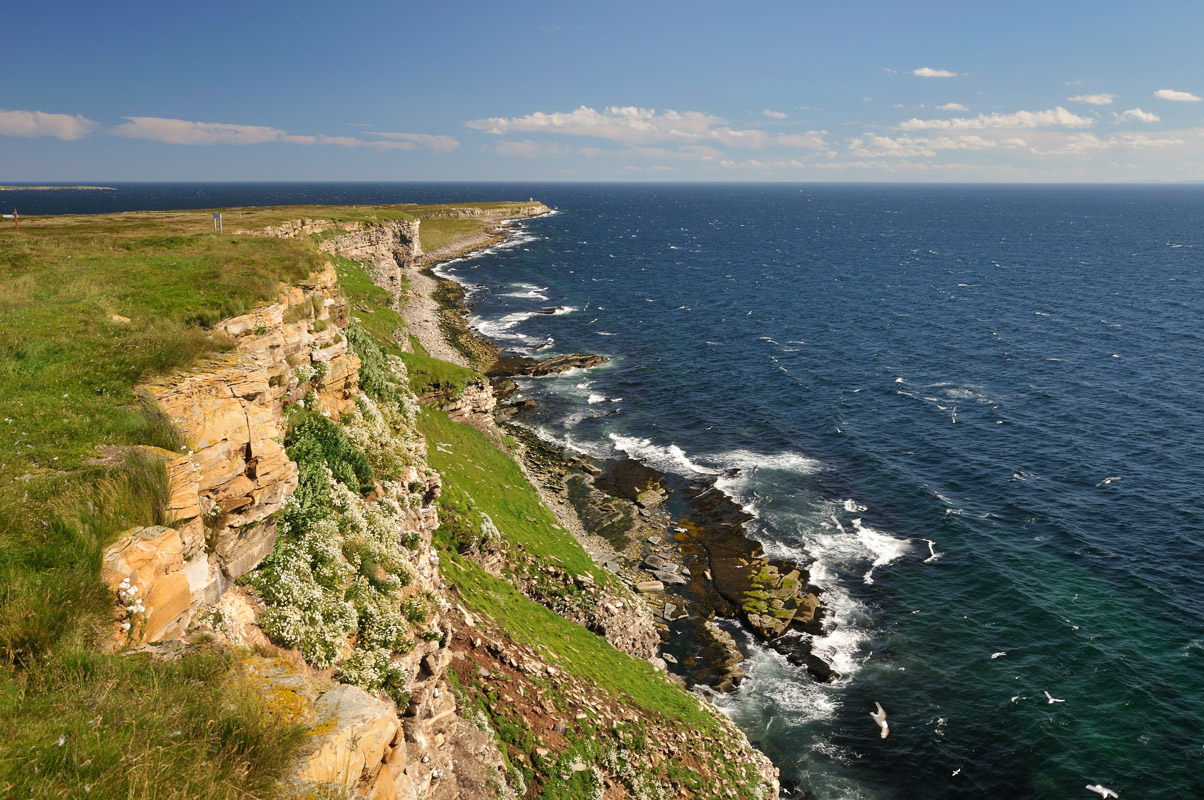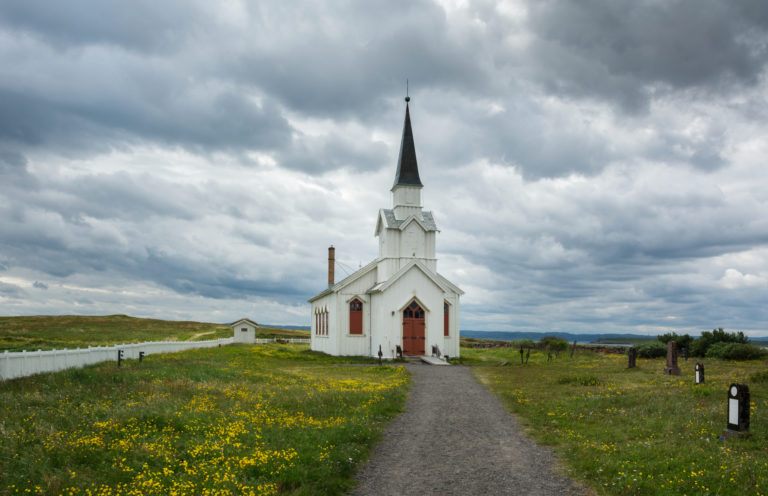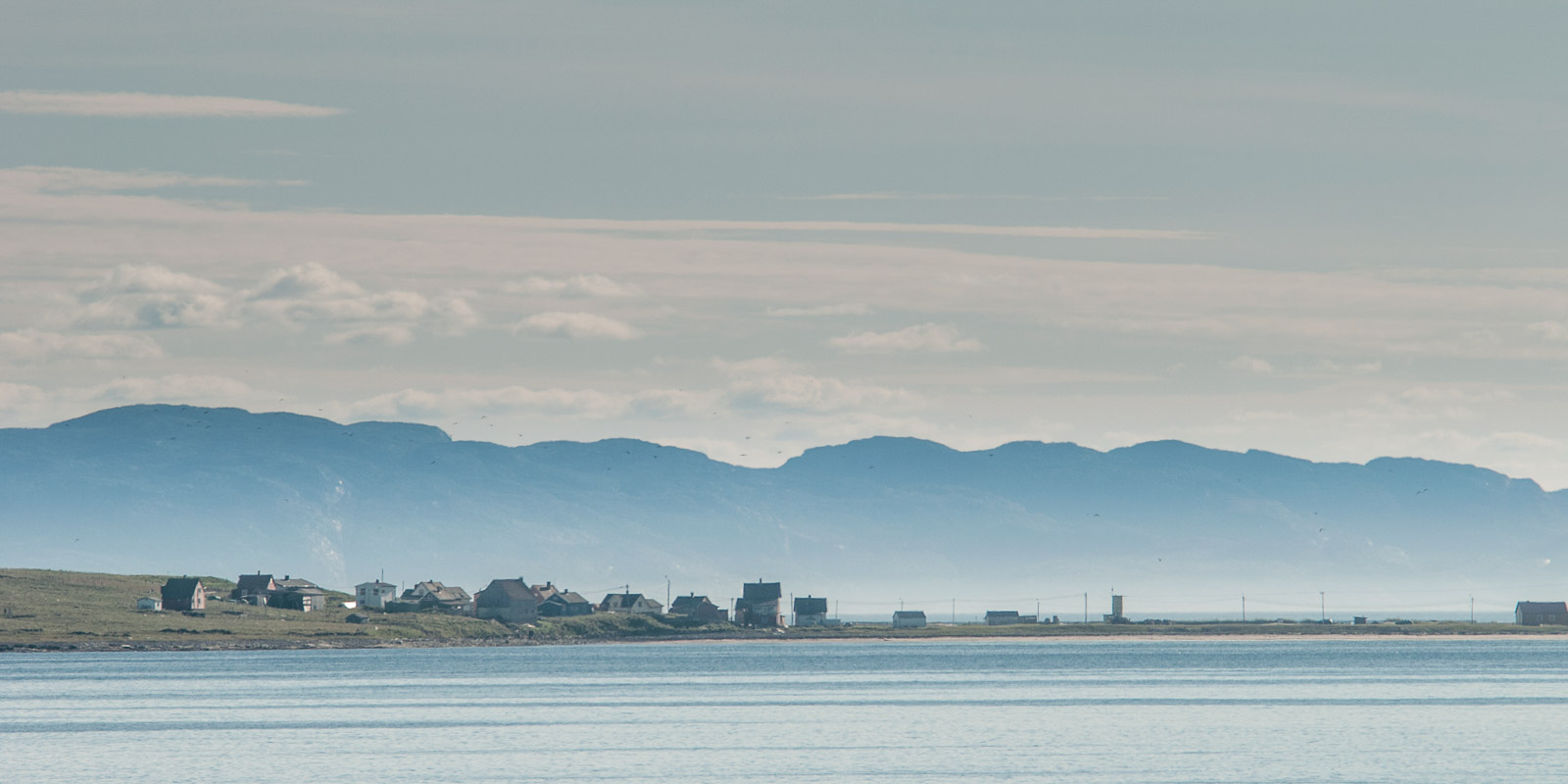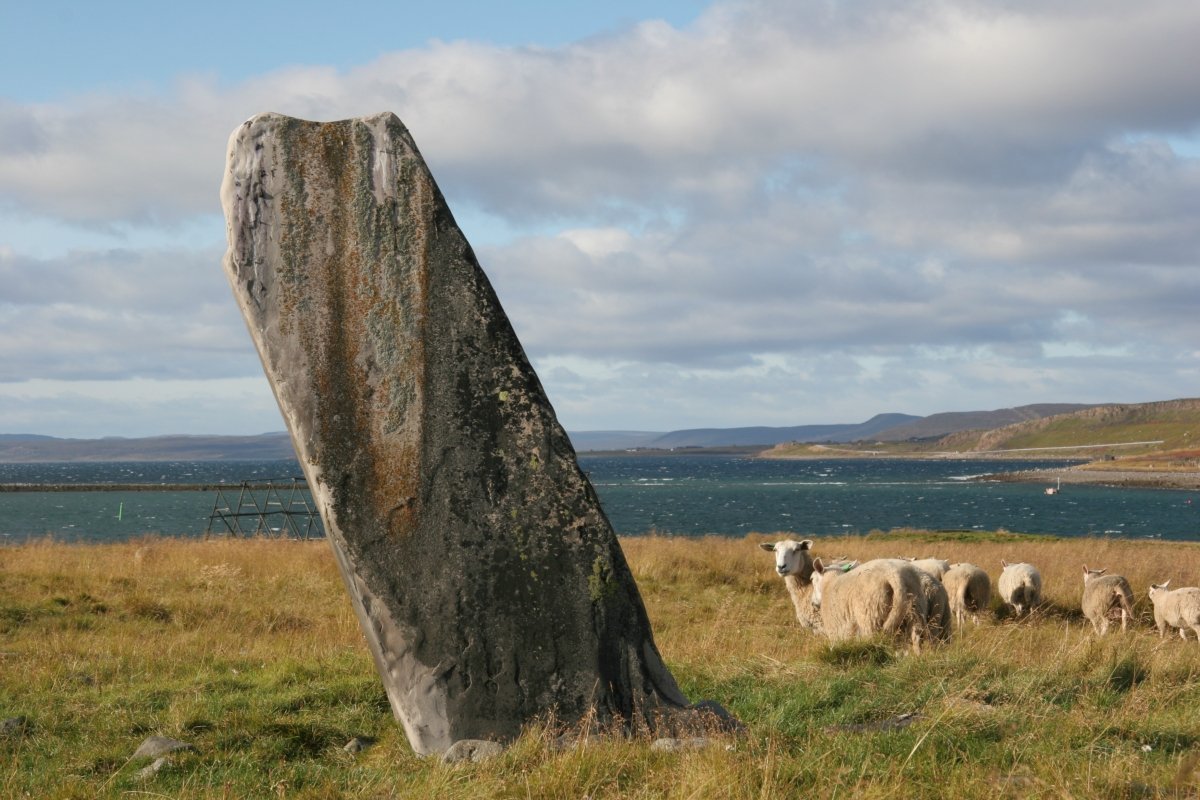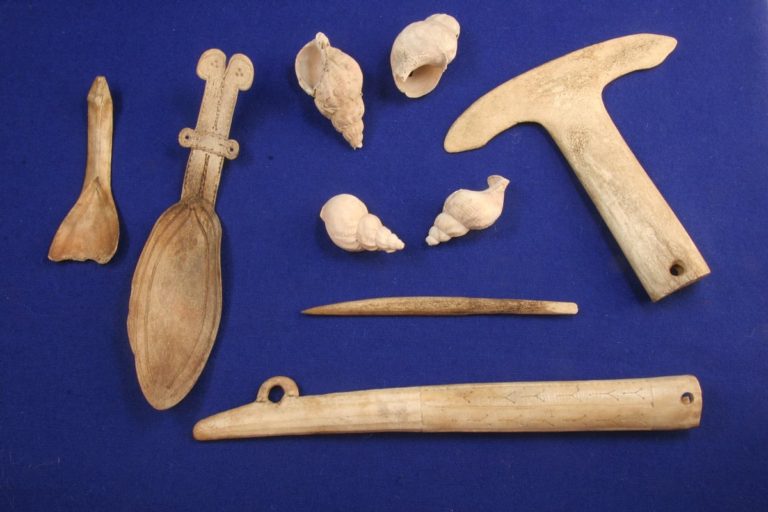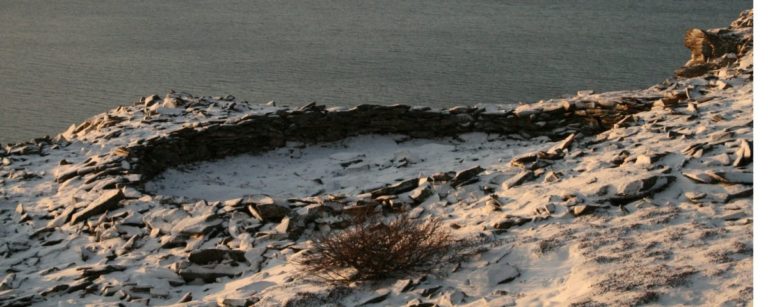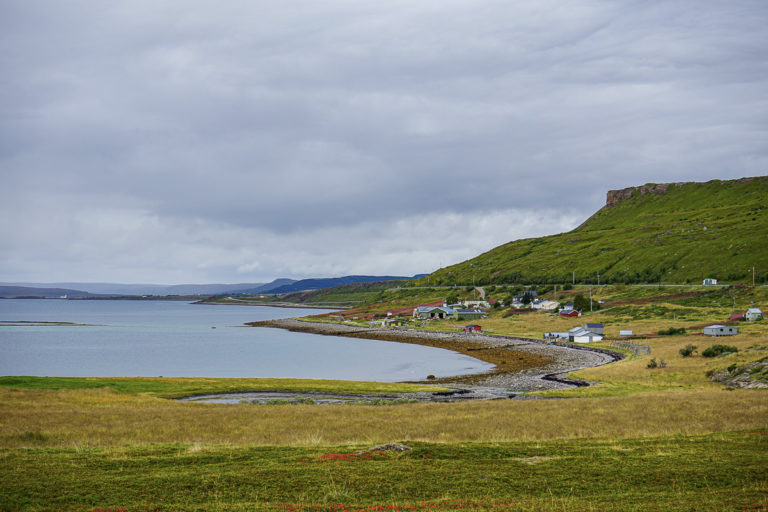The people and their culture around the Varanger Fjord show a unique continuity – from the Ice Age to the 21st century. The exhibit at Varjjat Sámi Musea/Varanger Sami Museum accurately traces the long lines of this history.
The mighty Varanger Fjord is an Arctic cornucopia, teeming with fish and marine life. The plateaus and the forests around them are bountiful with wild game, berries and freshwater fish. That is why humans have made a home here for more than 10,000 years. Varjjat Sámi Musea/Varanger Sami Museum follows one culture after another, right up to the coastal Sami culture present in these coastal communities today. Join us for a walk through history.
It all begins with the fjord
The exhibit at Varjjat Sámi Musea/Varanger Sami Museum opens with a bang – simple, yet effective. When you walk in the door, you can see the entire fjord ahead of you. Eider ducks are swimming and a Sami couple – I’m assuming – are rowing a boat. The Varanger Fjord itself, surrounded by low forests, plateaus and rolling hills, is our anchor through the exhibit – you move forward in time by walking around the fjord.
The first people came from the east
At some point, more than 10,000 years ago, the first people came to the Varanger Fjord. Recent research has shown that some areas around the White Sea and the eastern part of the Kola peninsula had less ice coverage than the Norwegian coast during that time. This made it easy to come in from the east. Other migrants may have come in from the west later on.
The oldest traces are found in the hills
At a settlement from the earliest times, there is a circle of large rocks. These rocks were used to pin the tent to the ground. In the centre are more rocks, used for cooking around the fire. All of this is found approx. 80 metres up in the hillside. The ice had suppressed the land, you see, and the sea level was higher. The land slowly rose, however, relatively quickly at first, and more slowly as time went on. We have to assume that people preferred to live near the water. That is how we can tell how old a settlement is – by seeing how high above sea level it is.
The diet was dictated by the fjord and the plateau
Wild reindeer defined the annual rhythm for Stone Age people, and they liked to hunt during the spring and autumn migrations, across the strip of land between the Tana River and the Varanger Fjord. The fish, seals and whales in the Varanger Fjord were also a key source of food. When the climate got milder, other animals, such as moose and beaver, moved in. The people here spent only a few hours a day making sure they had enough to eat, so they would have had plenty of time to be social, practice their religion and ceremonies and adorn their clothing and tools.
Rocks could be imported
The oldest tools discovered, were made from hard rock types, such as quartz and quartzite. A suitable tool for scraping a hide could be made by striking the rock with an equally hard rock, producing a sharp edge. Both the tools and the off-cuts have been discovered by archaeologists. Really hard rocks, suitable for tool-making, sometimes also came from far away. The oldest wooden tools found date back to 4700 BC – a digging stick and a sewing needle.
And advanced society emerges 3800 years ago
Around 1800 BC, the culture around the Varanger Fjord changed. At this time, the climate is a little warmer than in the last couple of millenia. Archaeologists have found the foundations of large peat houses with advanced roof structures. We imagine a population of several hundred people, distributed in relatively large settlements around the fjord. People are no longer nomadic, they stay in the same place year-round. This society had a clear hierarchy, with a leader at the top. The objects archaeologists have discovered were heavily adorned – the people were clearly fond of, and had the time for, aesthetics. This culture is called the Gressbakken culture, named after one of the sites.
Waste dumping grounds are a source of information
A copper dagger was discovered in a rubbish heap – full of food waste and broken tools. It was made with raw copper from Siberia, and was likely traded – hand to hand – all the way to Stuorravuona/Karlebotn. In these rubbish heaps, archaeologists have also found human remains. They may be slain enemies, or maybe the dead were kept around the living? Two approx. 4-cm long human figures made from reindeer horn were found in the same rubbish heap as the copper dagger, and may be a representation of ancestors or gods. They are currently the museum logo.
The Sami Iron Age
In the time before and around the year 0 AD, a culture known as siida emerged. The archaeologists call this a Sami culture, because it is closely related to the Sami culture we know from more recent periods. We don’t know very much about which ethnic groups were here in the thousands of years before this, but around year 0, local ethnic groups and cultural impulses from other regions meld together to form a Sami culture. This means the Sami identity likely developed close to home – it is not the result of a new people migrating here. This also means that the Sami culture is closely linked to past cultures in the area, but the details are lost to time.
Siida society existed for more than 1500 years
The Sami word siida refers to a local community, a group of people consisting of multiple families. This local community laid claim to an area where they make use of the natural resources available. The Sami people had annual migrations to hunt and fish. The people in Varanger became more nomadic again, perhaps because the climate cooled down and they had to move to get closer to the resources they needed. In Varanger, society was organized in siidas until the 16th/17th century, when their customs and religions underwent major transformations.
Burial gifts indicate what was important
A common burial method was to put the dead in a sled inside a rock mound. In a woman’s grave from the 5th century, archaeologists found traces of skis and a bow. Perhaps they believed the woman would need a bow to go hunting in winter? This speaks to gender roles in this society. The Roman historian Tacitus described Sami women who hunted. In a woman’s grave from the 10th century, discovered in Áppošborri/Abelsborg, the dead was covered in birchbark. She received several burial gifts, such as a dress pin, a spinning wheel, a garnet gemstone, a spoon made from horn and some snail shells.
Sieidit are holy places
The place of sacrifice is one of the most striking parts of the exhibit. A sieidi, a holy place, is often located near a striking rock formation. Different places were reserved for different deities, and the sacrifices were made at different times of the year. They sacrificed cod liver oil to the fish god for fair weather and a good catch. Reindeer were sacrificed for good luck on hunts.
The gods were in the heavens, on the earth and in the underworld
The god Raðði, who had created the heavens and the earth, held the top spot in the Sami god hierarchy. Earthly gods, such as Matteráhkká, received sacrifices of milk and spirits. The underground god, Ruto, spread disease and death, but could be appeased by a horse sacrifice.
The noaidi was in contact with the gods
The noaidi – the shaman – was the person within the siida who had the ability to commune with the gods. For this, they used a drum. The drum was made from a wooden frame or bowl, with a skin pulled tight across it. The skin was adorned with a myriad figures representing gods and sacred things. When the noaidi played the drum, they would go into a trance and were able to seek advice and help from the gods on the other side. The museum has a replica of the shaman Anders Poulsen’s drum, which was confiscated in 1692. The original is in the Sami Collections in Karasjok.
Reindeer hunting defined the annual rhythm
In good years, there were up to 40,000 wild reindeer in the Varanger area. They moved inland in the winter and migrated across the strip of land to the Varanger peninsula in the summer. The siida worked together on hunts in the spring and autumn. Long fences made from rocks, sticks and brushwood would lead the reindeer into deadly screes, or into pits where they could easily be killed. The reindeer hunt would have been both hard work and a major social event in the annual cycle.
Fur trade branching out
The Sami were also engaged in international trade. They hunted otter, stoat and beaver, and the soft hides were in high demand all across Europe. The beaver was hunted into extinction as a result. Walrus were hunted for their tusks, as well as for strong ropes made from walrus skin. The walrus, too, disappeared as a result of excess hunting. And finally, eider down was a major commodity. Ohthere of Hålogaland, a seafarer from Troms, who visited King Alfred’s court in England around 890 AD, described this trade. From the 11th century, merchants from Novgorod in Russia established a trading network that extended all the way to Varanger. We know this from burial gifts of Karelian and Russian origin.
Christianity was introduced in the 1600s
Christianity had been known through the Middle Ages, but in the 1600s, missionaries were especially active. This led to the confiscation of shaman drums, erection of churches and forced attendance at Christian services and religions ceremonies. The old customs continued in parallel to the new, however. In the beginning, it was customary to de-baptise children, essentially reversing the baptism. Until the mid-1800s, fishermen would rub cod liver oil on Transteinen – literally the cod liver oil stone – for good luck.
Reindeer hunting becomes reindeer husbandry
Wild game populations decreased from the late 16th century onward. Rifles were introduced, and Russian, Swedish-Finnish and Norwegian authorities all demanded taxes from the Sami. This is when some Sami started to domesticate the reindeer. There had been some domesticated reindeer in the past, often used to lure wild reindeer. Now, people started keeping large flocks of domesticated reindeer, and the wild reindeer population decreased. Today, all of the reindeer in Varanger is domesticated, as is the case in the rest of Norway, too.
Borders closed in 1852
Winter pastures for domesticated reindeer lay on the Finnish side of the border, whereas the Varanger Fjord and the Varanger peninsula was where the summer pastures were. The Lapp Codicil, an agreement between Norway and Sweden-Finland from 1751, granted to the Sami the right to cross the border with their reindeer. In 1852, when Finland became a Grand Duchy under Russia, the border was closed to reindeer migrations. That meant some had to stay on the Finnish side in the summer, whereas other had to find new winter pastures in Norway. Migration paths that had persisted for millennia, shaped by the climate and natural resources, were blocked.
Varanger Sami are coastal Sami
Coastal Sami are Sami people who live along the coast and fjords across large parts of Northern Norway. Traditionally, they engaged in hunting and fishing, both out to sea and in inland rivers and lakes, and farmed animals, including cows, sheep and goats. The coastal Sami culture was especially strong along the Varanger Fjord, and the Sami here are often called Varanger Sami. From the 1600s onwards, the Varanger Sami started switching between two settlements. In the past, they had had more than this. In the winter season, they stayed near the bottom of the fjord, where there was plenty of fuel and easy to hunt and fish. In the summer season, they moved closer to the mouth. This was closer to the fishing grounds, and Russian traders, called Pomors, often visited to buy dried fish. The livestock found good and plentiful grazing grounds. This seasonal migration lasted until the 1940s in some places.
A variety of turf huts – some simple, some more advanced
The Varanger Sami Museum has several turf huts on display. The simplest of them is the round arch hut, the bealjegoahhti. The structure consists of two arches, made from bent tree trunks, which are then covered with sticks and turf, with a hearth at the centre. The stave hut is a more advanced structure, and it allows for the construction of larger, rectangular buildings, with room for both livestock and people. In the 20th century, timber-framed houses in the Norwegian tradition became more common, but the turf hut returned in 1944, when much of Varanger was burned and destroyed.
Greeted by daily life
Objects from everyday life for different generations are on display in the Varanger Sami Museum. There are cheese moulds, and we can read about rømmekolle, a traditional dish that improved vitamin C absorption after a long and dark winter. Birchbark baskets were used for berry picking. A line of fish heads on a fence were dried to be used for animal feed in the so-called “spring plight”, when there was a shortage of feed. All tools are from modern times, but they are based on knowledge dating back millennia.
The Norwegianization policy rears its head in Varanger
For two thousand years, maybe even longer, Sami language and culture reigned supreme in the inner parts of the Varanger Fjord. In 1851, however, Parliament established the so-called Finn Fund, a grant to teachers who worked hard to Norwegianize the Sami. From 1898, the use of Sami language in classrooms was outlawed, and they also attempted to keep the children from speaking Sami during recess. The Sami communities along the Varanger Fjord, however, kept their language, and their culture. Children came to school without knowing any Norwegian, and the teachers had to mime, draw, or take the illegal step of using an interpreter to be able to communicate with the children.
Sami culture persists
In the late 19th and early 20th centuries, education was limited, and the children returned to a near completely Sami lifestyle. Class photographs from this era show that all of the children wear the traditional Sami costume. Norwegians and Kvens who joined the community during this time also started wearing Sami costumes, because they were practical and it helped them fit in. The Norwegianization process was slow.
The war was a watershed event
In the 1930s, Norwegian everyday clothing became more common. On Sundays and on special occasions, however, the Sami costume remained the preferred choice. As special occasion garments were made at home, from imported fabrics, no more costumes were made during the war – it was impossible to get the fabric. In 1944, most people in Varanger took to the mountains and thus avoided being forcibly evacuated south. Most houses were burned, however, and old objects and costumes were lost. The 1950 census was the last to register ethnic affiliation in Norway, census representatives simply asked which language was spoken in the home. 60 percent of the respondents said Sami.
Norwegian gains ground, even if the Norwegianization policy is abandoned
In 1959, the official Norwegianization policy was discontinued. Even so, Norwegian had become a language most people could speak, and many spoke Norwegian with their children, so they would not have to go through what their parents went through when they went to school. This meant that from the 1960s, children already knew Norwegian when they started school. Education also improved, and the children were often sent to boarding schools, where they would speak Norwegian. More and more young people were thinking about moving out of the community to find job opportunities, and it became important to be proficient in Norwegian, both for practical reasons and because Sami people faced discrimination in Norwegian-speaking communities in Finnmark. The traditional Sami costume had also largely disappeared from everyday wear. This means that most people transitioned to speaking Norwegian after the Norwegianization policy had been abandoned.
Return of the costume, and then the language
In 1970, only one of the candidates for confirmation in Nesseby wore a Sami costume in the group photo that was taken. As the 1970s progressed, however, more and more people started wearing it, and wearing one in the 17th of May parade became a source of pride. On trips to Vadsø, however, people did not wear their costume, or they were likely to be the target of slurs. In 1970, some parents requested instruction in Sami in school, but this was not implemented until 1977. The movement gained momentum in the 1980s, and Sami became a compulsory subject from 1992. If you speak Norwegian at home, you will learn Sami as a foreign language. If you speak Sami at home, initial training is in Sami. This means that in Varanger, young speakers are more proficient than middle aged and older speakers.
The Coastal Sami in the year 2000 exhibit shows both innovation and tradition
The photographic exhibit “Coastal Sami in the year 2000”, which was when the exhibit was created, shows daily life and people from Varanger, living in the modern version of coastal Sami culture. Here, modern technology and international entertainment meet the need to secure the berry harvest and the joy of biting fish in the Varanger Fjord. One does not exclude the other.
Competition with new interpretation of Sami crafts
Once you have moved through 10,000 years around the Varanger Fjord, you may be in the mood for something lighter. In 2016, the Varjjat Sámi Musea/Varanger Sami Museum held a duodji competition. Duodji is Sami handicraft from the entire Sami territory in Norway, Sweden, Finland and Russia. The result is a colourful collection of costumes, braided ribbons, belts and shoes. Some of the knife handles have traditional patterns, others playfull include more modern elements. Those fond of criticizing others for not wearing traditional costumes the “correct way”, nicknamed the bunad police in the rest of Norway, do not exist in Samiland, so new and old elements peacefully coexist, side by side. Who’s to say a pink jacket wouldn’t be pretty, and pumps can be appropriate footwear with the costume?
Visit Varjjat Sámi Musea/Varanger Sami Museum
Varjjat Sámi Musea is located right next to what may be Eastern Finnmarks most important crossroads, i.e. where the E6 and E75 meet. Whether you are coming from Kirkenes, Northeastern Finland, Karasjok, Vadsø or Tana, this is where you’ll end up. Nowhere else is the coastal Sami people represented as well as here, or with such long historical lines. We also recommend a visit to Ceavccageađge, Mortensnes, a ten to fifteen-minute drive toward Vadsø. This is an archaeological site of great importance, which ties in nicely with the museum. The museum has a small gift shop, with books on archaeological, cultural and Sami topics, as well as local handicrafts.
The last Saturday in August is the best possible time to go
The museum is open year-round, but the best possible time to go is the last Saturday in August. That is when the Sami market, Vuonnamárkanat takes place. Get your hands on berries, mushrooms, fish and meat. There is no better occasion to taste your way through 10,000 years of history along the Varanger Fjord. The cultural significance of this kind of market cannot be overstated, but the whole affair is simple and local, with a very laid-back vibe. Most people would love it.
Practical to know about Várjjat Sámi Musea – Varanger Sami Museum
Várjjat Sámi Musea/Varanger samiske museum (English Varanger Sámi Museum) is where the E6 and the E75 meet in the little village of Vounnabahta, Norwegian Varangerbotn in the municipality of Unjargga – Norwegian Nesseby. The museum is well signposted, and is found a few steps from the crossing towards Kirkenes.
Varjjat Sámi Musea / Varanger samiske museum /Varanger Sami Museum – is open all year Monday to Friday. For updated information consult their website.
If you drive between Varangerbotn and Vadsø, you can stop at the picturesque little church of Nesseby. Further on, the archaeological site of Ceavccageađge /Mortensnes invites to a long walk. If you drive towards Kirkenes, you can visit the colourful fishing village of Bugøynes with its Finnish heritage. Don’t miss the Skolt Sami museum at Neiden, a bit further on.
Nope, the service stops at coffee. However, there is a cafe across the road, and diagonally across the big crossing, there is the world’s northernmost Italian restaurant.
